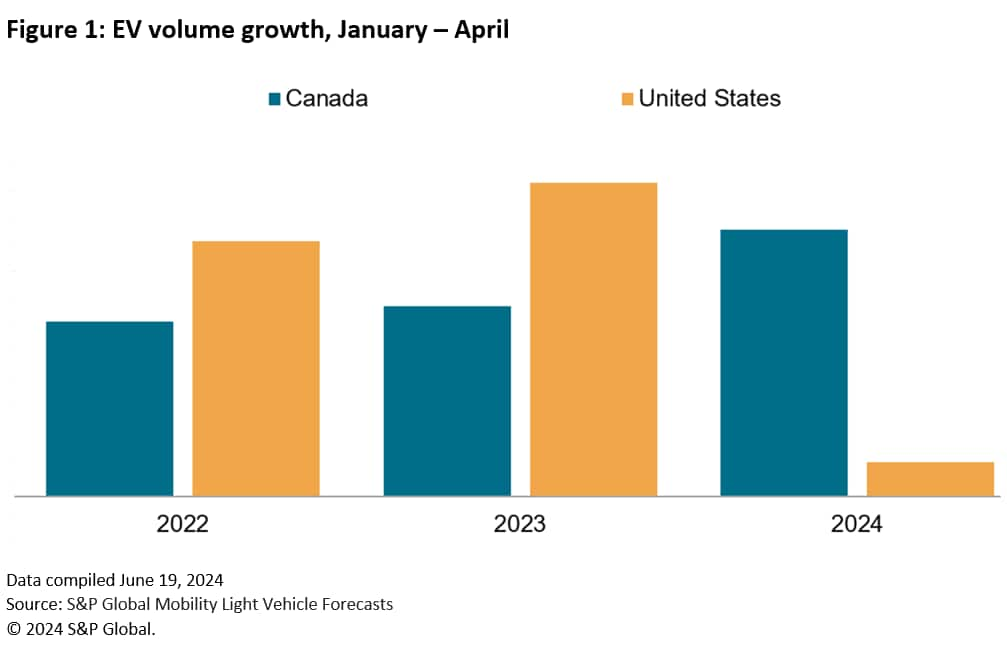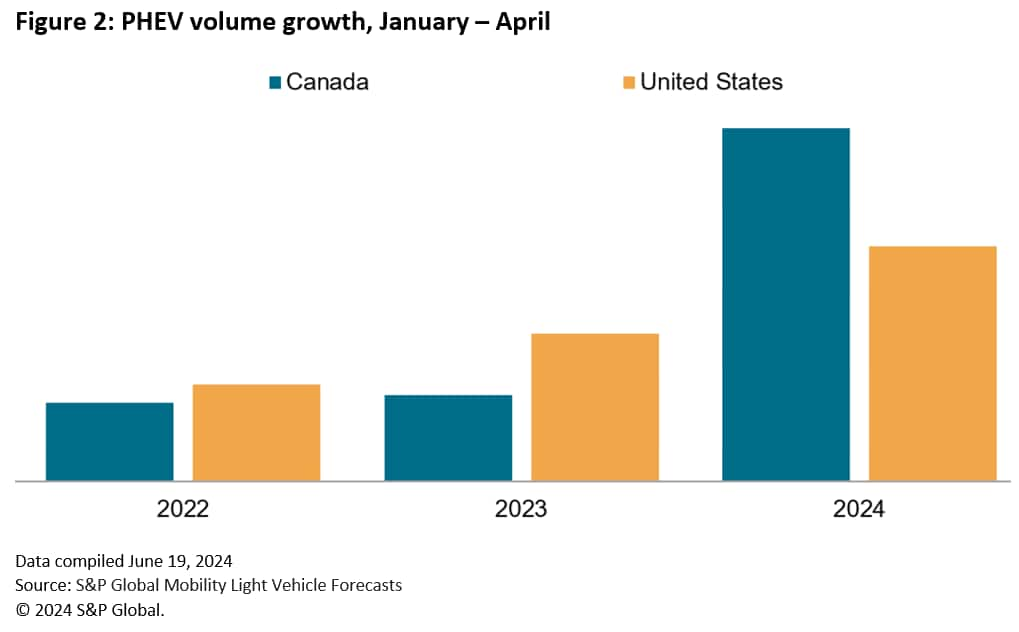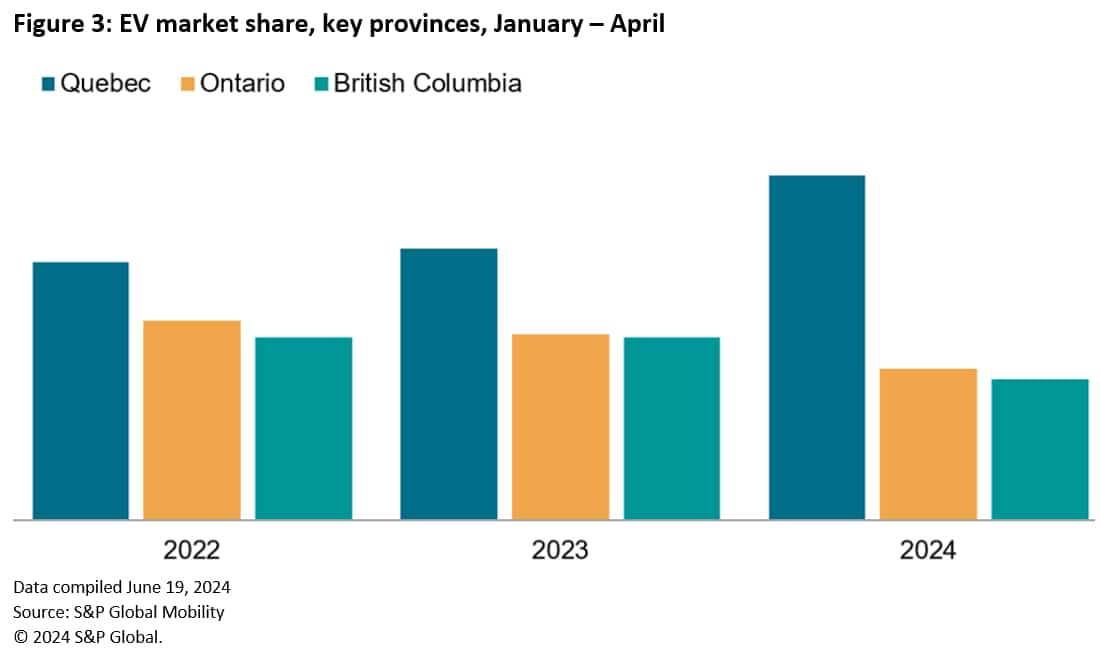Customer Logins
Obtain the data you need to make the most informed decisions by accessing our extensive portfolio of information, analytics, and expertise. Sign in to the product or service center of your choice.
Customer LoginsMarket share of EVs rises more quickly in Canada than in US
Though it has been well reported that buyers in Europe and China have adopted BEVs more quickly than US buyers, the same is true when looking at the US versus Canada. In Canada, the presence of provincial incentives in Quebec and British Columbia seem to be contributing to overall Canadian electrification adoption, but also to the representation of BEVs in those two provinces. In the US, with its 50 states and more complex market, state-level incentives seem to have less impact on the geographic distribution of BEV registrations.
We have taken a dive into the registration data in Canada and the US from January through April 2024, comparing it against the same periods of 2021 through 2023, to explore differences between the two markets. In both countries, both BEV and PHEV share continues to expand and the volume of registrations grows.
However, in the US growth is happening more slowly than in recent years. In Canada, BEV registrations improved 57% from 2023 to 2024, bringing share up as well. In Canada, PHEV registrations increased 75% over the first four months of 2024. In the US, BEV market share and volume growth have both slowed. The US saw about 25,000 more BEVs registered in January to April 2024 than the same period of 2023; volume increased about 137,000 units in the January to April 2023 period compared with 2022.


Canadian provincial incentives could reduce BEV price by CA$12,000
Canada's overall vehicle market is notably smaller than the US market, but broader application of the Canadian national zero emissions vehicle (ZEV) rebates—as well as Canada's decision to work toward a ban on ICE vehicles by 2035—are helping support faster adoption. Canadian provinces Quebec and British Columbia both offer incentives on top of the national government program and those provinces see above-industry BEV penetration rates.
Canada's national Incentive for Zero-Emission Vehicles (iZEV) sees some EVs eligible for up to CA$5,000 rebate at point of sale for a purchase or a lease of more than 12 months (though the amount is prorated and based on the lease term). As with the US, the list of vehicles which are eligible changes. Canada's national program has electric range requirements (which impacts PHEV eligibility) as well as vehicle price restrictions.
Quebec's program is more transparent and has fewer restrictions; instead of calling it a rebate, it is called a financial assistance program. In 2024, up to CA$7,000 can be applied to purchase or lease of a BEV or CA$5,000 for a PHEV. It has no income restrictions but does have pricing restrictions and is being phased out.
Among the reasons Quebec has been aggressive on the BEV front is that the province gets a substantial amount of its electricity from hydropower and can support BEVs with renewable energy. In Quebec, assistance drops in 2025 and 2026, and in 2027 is phased out completely. In British Columbia rebates depend on the buyer's income as well as vehicle price and type, with up to CA$4,000 for BEV or extended-range EV and up to CA$2,000 for PHEVs. The province of Ontario, however, has resisted offering any incentive; residents there can only access the national plan.
Canada's national program and a national policy more consistently supportive of BEVs contribute to BEV and PHEV adoption. However, the provincial-level incentives seem to drive regional adoption, with Quebec consistently accounting for most EV registrations in Canada. Through April 2024, Quebec registrations accounted for 50.6% of Canadian BEV registrations; British Columbia counted for 20.6% and Ontario captured 22.5%.
Quebec and British Columbia account for more BEV registrations than their natural registration distribution across the country. In overall vehicle registrations, Ontario accounts for about 39% of vehicle registrations, followed by Quebec at about 24%, Alberta at 12%, and British Columbia, which is narrowly behind Alberta at 11.6%. If BEV adoption in Canada mirrored overall vehicle registrations, Ontario would also lead BEV registrations and be substantially ahead of Quebec and British Columbia.
Instead, Quebec has held a leading position, followed by Ontario and British Columbia. There is also evidence of some change here as well, with Quebec's share of Canadian EV registrations taking a significant jump the first four months of 2024.

However, when looking at registrations within each province, in Ontario BEVs make up barely 5% of registrations in the province from January through April 2024, compared with the national BEV share at 8.5%. In British Columbia, BEVs accounted for nearly 15% of vehicle registrations. In Quebec, BEVs accounted for 18% of vehicle registrations. BEVs are overrepresented in Quebec, which has the simplest BEV rebate logistically. In Alberta, there are also no additional incentives, and BEV share there was 2.1%.
Currently, buying a BEV in British Columbia or Quebec has potential for CA$9,000 in total incentives. The adoption of BEVs is in Quebec is easily the strongest in Canada. And in those two provinces, BEV share is far above the national average. In high-volume provinces where there is no added incentive, BEV share is lower than the national average. The provincial BEV incentive programs are contributing to Quebec and British Columbia capturing more BEV share than larger new-vehicle markets as well as being well ahead of national BEV penetration.
State-level incentives have mixed impact in US
In the US, BEV registrations are still highly concentrated in the state of California. Like Quebec, California over indexes in BEV registrations beyond what can be explained simply by its state-level incentives. In the US, the states which offer incentives also have more varied programs, which presumably creates more variability in impact of state-level programs in the US.
California has also led with more strict vehicle emission rules for decades, it has typically been a trend setting, early adopter state inside and outside the auto industry as well as often being a digital technology leader and embraced Tesla very quickly. In the January through April period, California accounted for 34% of US BEV registrations; the state's dominance of the BEV market is assisted by state-level incentives. It was followed by Florida, however, with 8% and no state-level incentives. Texas is third, with 7% of US BEV registrations and a more modest US$2,500 incentive.
There are a total of 15 states in the US offering some level of incentive on top of federal incentives, but BEV distribution in the US does still generally see the highest volume states in overall registrations also being the top BEV states. Within California registrations, BEVs account for 21.4% of the total vehicles registered, also far above the national-level BEV market share of about 7%. BEVs accounted for 6.6% of total Florida vehicle registrations, close to the national figure, while in Texas, BEVs are at 5.2% of vehicle registrations so far in 2024.
The incentive in Texas, a more modest amount than California offers, has not pulled the BEV share in Texas above the national average. No other US state accounts for more than 4.5% of BEV registrations, regardless of the size of any incentive.
Get a free trial of AutoIntelligence Daily.
This article was published by S&P Global Mobility and not by S&P Global Ratings, which is a separately managed division of S&P Global.

